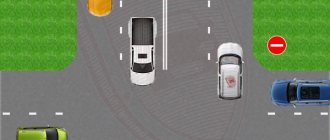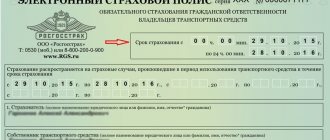Punishment for non-compliance with rules
The Code of Administrative Offenses provides for administrative liability for pedestrians in case of violation of rules of conduct on the road. A fine of 500 rubles or a warning is possible if traffic rules are ignored (Article 12.29 Part 1 of the Administrative Code). However, this is not the only type of fine for violators. If their actions interfered with traffic, the penalty increases to 1 thousand rubles (Article 12.30 Part 1 of the Administrative Code).
If, in addition to interference, slight or moderate damage to the health of other people occurs, the fine may increase to 1-1.5 thousand rubles (12.30 Part 2 of the Administrative Code). A monetary penalty of this size is possible only if the pedestrian’s actions lacked intent and were committed through negligence.
Only the traffic police officer who discovered the offense has the right to fine. It is impossible to fine a person who is caught on camera, since his identity cannot be identified.
Important: The traffic police inspector is obliged to draw up a protocol on an administrative offense indicating the article of the Code of Administrative Offenses and the paragraph of the traffic rules that the pedestrian violated.
In the event of an accident involving a pedestrian, the offender must provide assistance to the victims and remain on the scene until the police or traffic police arrive.
Transition to prohibition sign
We all remember the rule from childhood: you can only cross the road in a designated place. For walking on the roadway, although there is a zebra crossing or an underground crossing sign nearby, you can be fined 500 rubles. Violation of a sign prohibiting crossing is punishable in the same way. You can’t ignore the sign with a white car on a blue background, which prohibits pedestrians from driving along the edge of the road.
But crossing a red traffic light is considered the most dangerous , as there is a risk of being hit by a car or forcing the driver to hit the brakes, causing an accident. For this offense you can also be fined 500 rubles.
In the wrong place
According to the rules, pedestrians must move only on sidewalks and pedestrian paths, and stick to the right side. If there are no places for pedestrians in sight, you can enter the road for cyclists or walk along the edge of the road towards traffic so that you can see the danger. Movement should not interfere with traffic.
Such an obstacle could be, for example, a pedestrian stopping in the middle of the road to answer the phone or unexpectedly appearing on the roadway after jumping over a turnstile. Crossing the road in a prohibited place will result in a fine of 500 rubles .
If you wish, you can pay only half of this money, for example, by paying off the fine in the first 20 days while the discount is valid.
Proof
Evidence of an unlawful act committed by a citizen on foot may be a recording from a car dash cam or video camera.
In addition, the violator has the right to be stopped by a traffic police inspector who controls the road section and was in the visibility zone when crossing the street incorrectly.
A motorist who sees an unlawful act by a person while crossing the road can do the following:
- Stop the car, call out to the offender, and inform him about unlawful actions on his part, holding an explanatory conversation.
- Report the offense to law enforcement agencies. In this case, it is required to take the offender to the police station and provide, as evidence of the violation, a recording from the video recorder.
The following scenario can be implemented:
- Stop the guilty person and inform him that the registrar or telephone has recorded his unlawful act.
- Call the traffic police squad.
- After the police arrive, explain the situation by presenting the video.
- After the police have drawn up a report of the offense, if the offender has identification documents, the motorist is required to sign the report.
- If the offender does not have documents, he will be sent to the police station to find out his identity.
Responsibility
There are three types of liability for pedestrian violators:
- Administrative (it is used most often).
- Criminal.
- Civil.
If by their actions they only interfered with the movement of cars and led to the appearance of abrasions, scratches, and bruises on other pedestrians or motorists, then they face administrative liability. A warning and administrative monetary sanctions are also applied if the victims have lost the ability to work for more than 21 days, but their lives are not in danger.
Art. 268 of the Criminal Code of the Russian Federation provides that criminal liability for pedestrians occurs if violation of the rules led to serious consequences for other persons (fractures, injuries, open wounds, etc.). Pedestrians are also involved if the victims lost a child as a result of an accident, became blind, or acquired mental illness.
Civil liability occurs if a pedestrian, by breaking the rules, causes damage to the owner of a car or other property. This damage can be not only material, but also in the form of health problems. In this case, the violator faces a lawsuit demanding compensation for losses on the basis of Article 1064 of the Civil Code of the Russian Federation. Not only an individual can act as a plaintiff. a person, but also a company . The damage must be compensated in full if it is proven that it was caused by a pedestrian.
Important: prosecution can be appealed. If you do not agree with the conclusions of the traffic police, you can always file a complaint with a higher authority or court.
Administrative
For minor violations, pedestrians are either fined 500-1.5 thousand rubles or even warned about the inadmissibility of such actions in the future. If the traffic police inspector decides to limit himself to a warning, the violator will not have to pay a fine .
Criminal
If a pedestrian caused an accident by his actions, and someone was seriously injured, then he faces prison for up to three years or forced labor for up to 2 years.
The same article 268 of the Criminal Code of the Russian Federation provides for the possibility of arrest for up to 4 months. Traffic violations that result in the death of a person are punished more severely. Violators can be imprisoned for up to four years or required to perform forced labor for the same period of time. If several people (or more) died in an accident, and the pedestrian was careless, and not his direct intent, then the prison term may increase to 7 years or it may be replaced with work for up to 5 years.
Civil
The extent of civil liability depends on the amount of damage caused. For example, a pedestrian ran into a red light and caused a collision between one car and another. If the repair is estimated at 50 thousand rubles, then this is the amount that the victims have the right to demand. There are no restrictions in this case, but no one has the right to demand more harm caused, which must be assessed by specialists.
The amount of compensation with supporting documents (invoices from service stations, independent examinations, certificates from clinics) must be indicated in the claim for damages.
You may also be interested in learning about the following fines for motorists:
- for violation of stopping or parking rules;
- for driving without documents;
- for hitting a pedestrian;
- for overtaking;
- for speeding;
- for lighting devices;
- for the absence of a warning triangle;
- for tinting front and side windows;
- for driving under the sign “Traffic traffic is prohibited”;
- for washing a car in the yard or on the river.
Who has the right to punish a pedestrian for crossing the road in the wrong place?
Not only a traffic police or traffic police inspector, but also any police officer, regardless of whether he is in a service or personal car, or without one at all, has the right to issue a report on a traffic violation when crossing a street in an unassigned area.
For example, a local police officer can draw up a report on unlawful actions of a pedestrian, based on Order No. 403 of the Ministry of Internal Affairs of the Russian Federation dated May 5, 2012, which sets out the powers of officials of the Ministry of Internal Affairs. The presence of a vehicle - official or personal - does not matter. When detaining an offending pedestrian, the policeman is obliged to introduce himself, show his official identification, draw up a report on the offense and hand the offender a copy of the compiled report.
If the policeman’s demands are not complied with in such circumstances, Art. 19.3 of the Code of Administrative Offenses of the Russian Federation regulates that failure to comply with a lawful order of a police officer leads to administrative punishment, up to and including detention for up to 15 days.
Traffic regulations for pedestrian road users
The traffic rules provide for a number of points regulating the rights and obligations of pedestrians (section 4, clauses 4.1-4.16). It is on them that traffic police rely when assessing the scale of violations.
The rules provide that:
- movement is possible only on sidewalks, places for pedestrians, in special cases on bicycle paths or in one row along the side of the road or along the edge of the road;
- at night, a pedestrian who decides to go out onto the roadway must illuminate his path so that motorists can see him;
- When moving along the road, you need to pay attention to the traffic controller’s gestures and the traffic light signal.
Pedestrians are prohibited from running onto the road or pedestrian crossing themselves or allowing children to do so. Crossing is not possible if there is a dividing strip or the road has four or more lanes, as well as in places where a turnstile or prohibitory sign is installed.
Where to cross the road?
You can cross the road along zebra crossings and underground pedestrian crossings. For pedestrians, there are also safety islands on highways or lines separating traffic in different directions.
If you are already on a busy highway, then you can wait in the middle (so as not to interfere with traffic). You can cross to the other side only if the traffic light switches to green or the traffic controller gives a sign.
If there is a car in front of you, you can go around it from behind only after making sure that there are no other cars nearby. You can go around the tram to exit onto the roadway only if it has already stopped on the side of the doors.
How to cross the road correctly?
Crossing the road correctly is not difficult. It is worth adhering to the established rules and using specially provided transitions.
A pedestrian has the right:
- Count on an advantage when crossing if he does everything correctly and does not violate traffic rules.
- Make claims to utilities and other services regarding traffic safety.
If there is no crossing and the road is three-lane, then you can cross it at right angles to the edge. You can only start moving if there is no danger nearby, after first looking to the right and left. At intersections you need to move along the line of sidewalks or curbs.
Payment methods for traffic police fines
You can pay the fine via the Internet (State Traffic Police website, State Services, Yandex services, WebMoney, Sberbank-online, etc.).
In addition, you can pay off the fine at any bank branch if you have payment details or in the terminal. There is no need to come to the traffic police department to pay the fine. This should only be done if you are overdue, have accumulated a number of fines and want to recalculate and receive the final amount to pay. Payment through banks or online services may require payment of a commission of up to 3% of the fine amount.
How to pay online at Sberbank?
You can pay the fine on the website of Sberbank of the Russian Federation. To do this, you need to register with Sberbank Online and gain access to your personal account. The procedure consists of several stages and takes no more than 5-10 minutes.
The only limitation: the service is available only to Sberbank cardholders and a phone at hand to which you will need to receive an SMS. To register, in the “Enter card number” column you will need to enter the number written on the front side of the card. The number will be promptly verified and an SMS will be sent to your phone to log into the site.
Instructions for paying fines:
- Register on the website of Sberbank of the Russian Federation (click on the “Registration” button).
- We look for a fine in the system by the resolution number (click the “Find fine” button).
- We pay the found fine amount (click the “Pay fine online” button).
- We receive payment confirmation by email or print it from your personal account.
- We can arrange an auto payment if desired (click the “Auto payment for traffic police fines” button).
The first step on the path to payment should be to find out the amount and type of fine , as well as your right to a 50% discount in the line “Enter the number of the administrative violation resolution.” It is unique and the system will immediately calculate the necessary information about fines and their amount. If there is a 50% discount (if paid in the first 20 days), then the total amount payable will be calculated taking into account the discount.
Once you have determined the amount of debt, you can go to the fine payment page. By entering the card number and CVV code, you can easily repay the required amount. You can save your payment receipt as a PDF file. Once you have finished paying off your fines, you can make an auto payment, i.e. automatic debiting of money from your card to pay for found traffic police fines.
The system will automatically collect information about all sanctions for traffic violations and pay them off by writing them off. If there is always a non-burnable amount on the card, then everything will happen automatically , and you will only receive an SMS about the completion of the transaction.
How can the traffic police prove your guilt?
Knowing traffic rules helps you get out of the most difficult situations. If you come across an inspector who is incompetent and is trying to illegally prosecute, you can, by referring to the necessary points of the rules, end the conversation in your favor. An inspector can prove a pedestrian’s guilt only by providing video evidence of the offense or by obtaining testimony from witnesses.
Photographic recording of violations will also help, for example, if a pedestrian ran out onto the road, then a photograph of the brake mark will help shed light on his guilt. If the pedestrian himself was injured and, for example, fell in the wrong place where he was crossing the road, then his location will also become indirect evidence of his guilt.
Controversial situations
It happens that drivers hit pedestrians who threw themselves under their wheels in order to receive monetary compensation immediately on the spot. In this case, fraudsters accurately calculate the trajectory of the fall in order to receive only minor damage. Fearing the arrival of the traffic police, the “guilty” driver tries to make amends with money.
This is usually done by those who do not know that the pedestrian is responsible, like all other road users. If this happens, then you need to wait for the arrival of the traffic police and get a protocol drawn up , which will record the fault of the pedestrian himself, and not the driver. Disagreements can also be caused by a situation when a pedestrian crosses the road in the right place, but, for example, he is not visible because the street is not lit.
In this case, according to traffic regulations, he is required to illuminate his way, but this happens extremely rarely. It is quite difficult to prove the driver’s guilt in such accidents, since formally the pedestrian is to blame. It also happens that a pedestrian crossing is closed for reconstruction, and there are simply no other options for passage. In this case, a pedestrian who has violated the rules may well file a recourse claim against the road services.
If a controversial situation arises, there is no need to hide from the scene of the accident. You need to exchange contacts with all participants in the accident, give explanations, participate in drawing up a diagram and protocol, which you can then appeal. Make sure that the protocol accurately reflects the position of the cars, your movement pattern, and the location of the victims and witnesses.
An accurate depiction of the situation can prove your innocence. To help victims - data from video recorders or external surveillance web cameras . With their help, you can reconstruct the accident minute by minute and determine who was at fault.
How to appeal a decision?
For vehicle drivers and pedestrians who believe that their punishment is unlawful, a unified procedure for appealing decisions has been established. Action steps:
- sending an application to the head of the traffic police department where the offense was recorded (response period – 30 days);
- if there is no result or the decision turns out to be unsatisfactory, a statement of claim is sent (to the court at the place of registration of the department).
The claim must be accompanied by supporting documents and witnesses. If the court makes a decision to cancel, the applicant receives an extract, which must be submitted to the traffic police to carry out the action. Only 10 days are given to submit an application from the date of drawing up the protocol.









